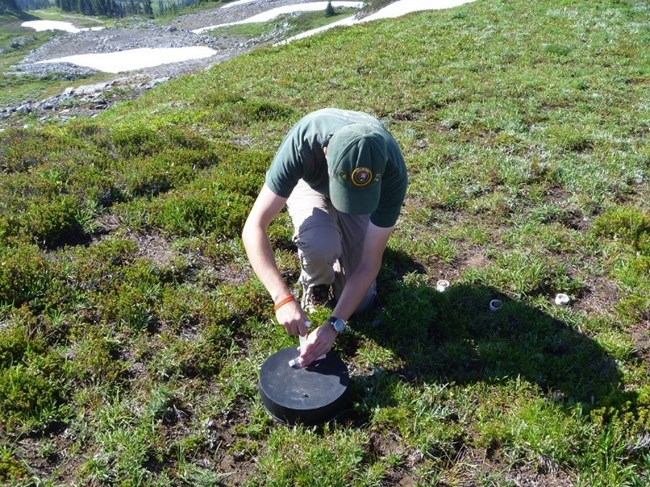Last updated: July 17, 2018
Article
Snowmelt as a Driver of Ecosystem Composition and Processes in North Coast and Cascades Parks
Introduction
Snow is a significant reservoir of nutrients in the Cascade Mountains. Even subalpine locations remain snow covered for a majority of the year, resulting in short but active growing seasons. Snowpack acts as a reservoir of nitrogen (N), and snowmelt results in pulses of N delivered to ecosystems.
Current N deposition rates in the Cascade range from 0.3 to 0.4 g N/m2/yr (grams of reactive nitrogen per meter squared per year) Reactive, inorganic N (the only form that can be used by plants and soil microorganisms) is nearly an order of magnitude higher than background rates of 0.04 to 0.07 g N/m2/yr which originate from natural sources.

Methods
In 2013, for his doctoral research, Dr. Justin Poinsatte monitored N concentrations in snowpack and associated ecosystem processes in Paradise Meadows at Mount Rainier National Park (MORA). This study focused on three subalpine meadow communities that are distinguished by their date of snow release: 1) sites that melted out in mid-July (early), 2) sites that melted out in late July (mid), and 3) sites that melted out in mid-August (late).
2013 Results
Ecosystems are composed of plants, animals, and microscopic organisms that live in the soil, of which we cannot see, yet they drive nutrient cycling. These soil microbes transform detritus into usable reactive forms that fuel plants and microbes. In this system microbes specifically transform N from deposition into usable forms.
- The levels of ammonium (NH4+) were greater in snowpack than nitrate (NO3-) suggesting that the N from deposition is of agricultural origin.
- Microbial biomass was greater in the early communities followed by mid then late. This indicates high amounts of microbial activity in soil and processing of N.
- Soil microbial communities readily use this N and release nitrous oxide (N2O) and carbon dioxide (CO2) during metabolism, both of which are greenhouse gases (Figure 1).
- Leaching is a physical process that occurs when there is excess N in the system. Leaching can cause the soil to become acidified altering soil microbes, plant nutrition, and plant health. Leaching is particular. High levels of N can adversely affect oxygen levels for humans and aquatic systems. Early snow release sites had higher leaching of NH4+ than mid or late sites.
In 2014 Dr. Poinsatte furthered his study by applying N in amounts mimicking potential future deposition (+0.3, +0.5, and +1 g N/m2/yr) at the research sites.
2014 Results
- Peak N2O emissions from the applied N occurred immediately after snowmelt.
- This pulse of N likely caused rapid soil microbial processing increasing soil N2O release.
- Early communities had significantly higher annual inorganic N leaching than the late communities. This might be due to the fact that communities senesce in the fall and re-grow biomass in the spring. At the time of early snowmelt their phenology (life cycle timing) is not in sync with the early snowmelt. Plants are thus unable to incorporate excessive N from snowmelt leading to increased potential for leaching (Figure 2).

- Under the greatest application rate (+1 g N/m2/yr) the leaching rate was approximately double the leaching rate observed in 2013, when no N was added.
Application in the NPS
Nitrogen leaching rates from earlier snow release communities may be high enough to exceed montane watershed critical loads for N. A critical load is the threshold of deposition below which specified harmful ecological effects do not occur. Earlier snowmelt could also result in limited growing season moisture, inducing stress and drought.
Models projecting future climate change and N deposition under business as usual show increased soil emissions of CO2 and N2O over time.
As climate change continues we expect to see early snowmelt across all communities and a potential shift from mid and late communities to early snowmelt communities (Figure 3).
Nitrogen deposition will continue to increase unless policy is enacted to reduce pollution. Thus greater amounts of soil N versus plant N in early and mid-communities are projected, increasing leaching potential.

Researcher
Justin received his Bachelor’s in Biology and History from University of Notre Dame and a PhD in Botany from Washington State University. In addition he was a NSF-NSPIRE student working to bring policy and science together. During his PhD he worked throughout the Cascades at Mount St. Helens and Mount Rainier studying biogeochemical cycles and processes. He is now working for the Wisconsin Department of Natural Resources.
More Information
Regina M. Rochefort, Ph.D.
North Cascades National Park Service Complex
Email: regina_rochefort@nps.gov
Phone: 360-854-7202
Tonnie Cummings, NPS Air Resource Specialist
Pacific West Region
Email: e-mail us
Phone: 360-816-6201
Justin Poinsatte, PhD
Email: jpoinsat@alumni.nd.edu
Prepared by: Rebecca Evans
Graduate Student, Washington State University
Air Resources Assistant, GeoScientist in the Park
